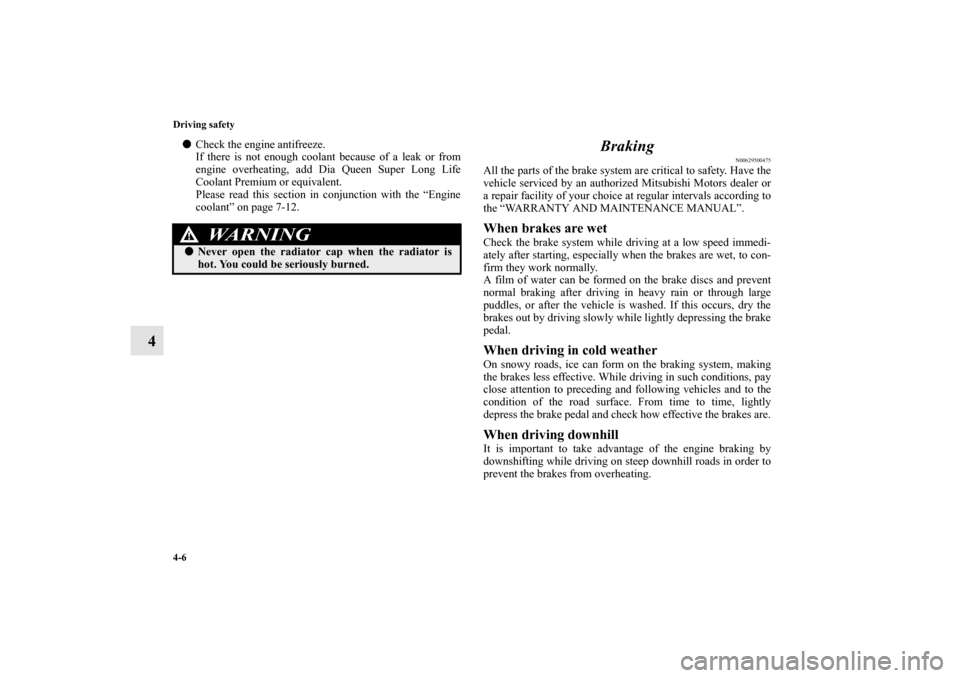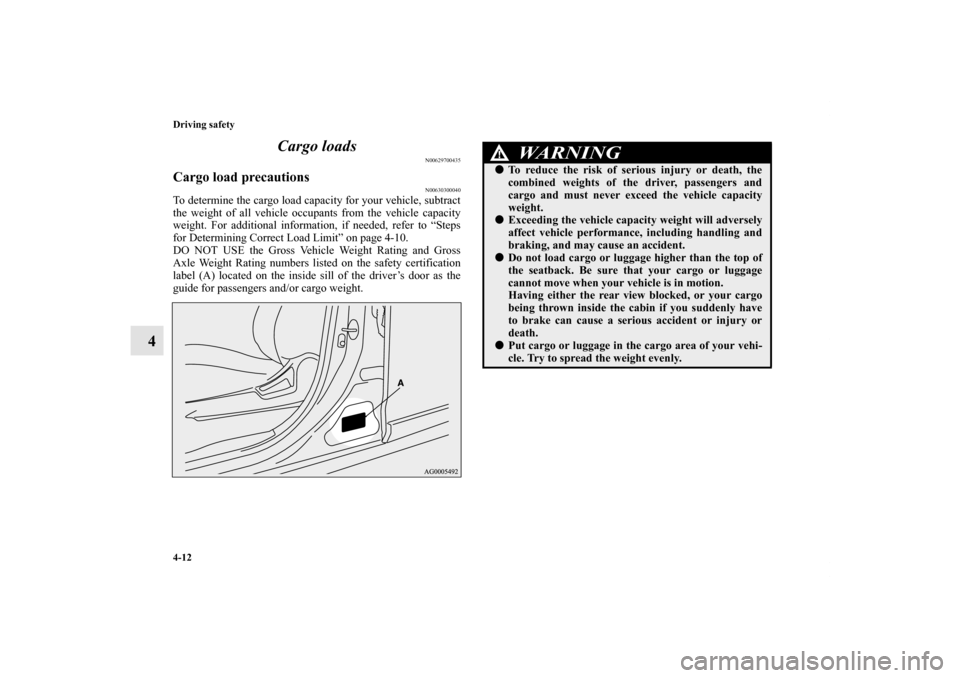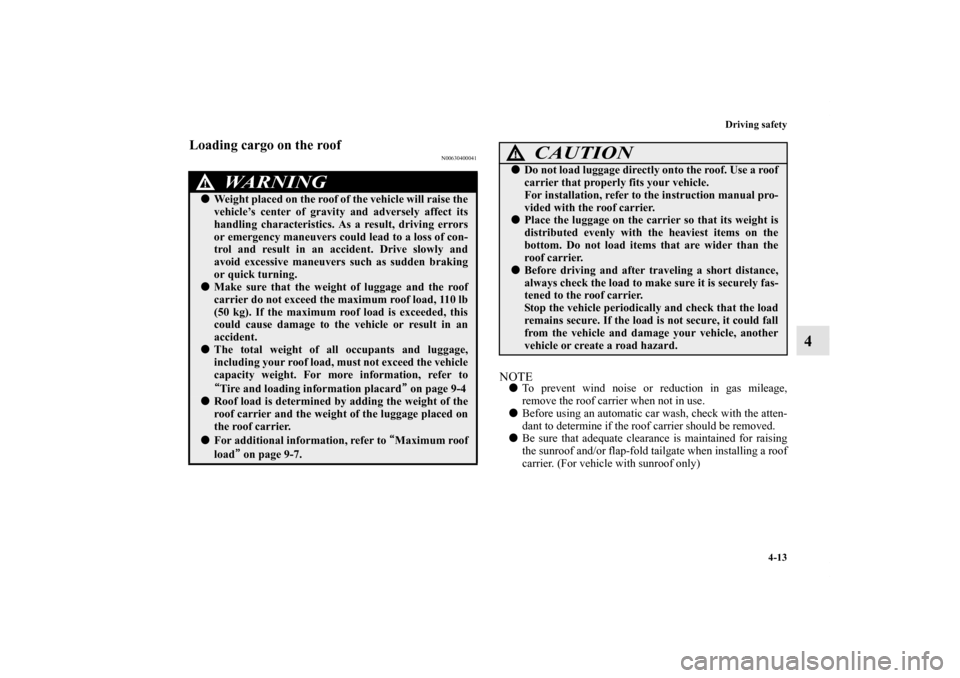Page 374 of 714
Features and controls
3-259
3
Enrollment Commands
N00566400054
USB input terminal
(if so equipped)
N00566700015
You can connect your USB memory device or iPod* to play
music files stored in the USB memory device or iPod.
The following explains how to connect and remove a USB
memory device or iPod.
Refer to the following sections for details on how to play music
files:
Refer to “To play tracks from USB device” on page 5-97.
*: “iPod” is a registered trademark of Apple Inc. in the United
States and other countries.
BK0122500US.book 259 ページ 2010年5月12日 水曜日 午前11時11分
Page 389 of 714
3-274 Features and controls
3
Lower glove compartmentThe lower glove compartment can be locked and unlocked
using the key.NOTE�In vehicles equipped with the F.A.S.T.-key, the glove
compartment can be locked and unlocked with the emer-
gency key.
Refer to “Emergency key” on page 3-34.
�When the lights are illuminated with the light switch in
the “ ”, “ ” or “AUTO” position (vehicles with auto-
matic light control), the glove compartment light illumi-
nates.Pen holder
There is a pen holder on the inside of the lower glove compart-
ment.
NOTE�There is a limit to the size of pen that fits. Forcing large
pens into the holder could cause damage.
1- To lock
2- To unlock
3- To open, pull the lever (A)
BK0122500US.book 274 ページ 2010年5月12日 水曜日 午前11時11分
Page 391 of 714
3-276 Features and controls
3
Floor console box
N00551600221
Type1To open the console box, lift the release lever (A) and raise the
lid.
Type2Upper and lower boxes are located inside the floor console
box.NOTE�The floor console box can also be used as an arm rest.
Refer to the “Arm rest” section on page 2-11.NOTE�The Auxiliary Audio connector (RCA) or the Auxiliary
Video connector (RCA) is located in the floor console box
(if so equipped). For details, refer to “To use the external
audio input function” on page 5-118.
�The USB input terminal is located in the floor console box
(if so equipped). For details, refer to “USB input terminal”
on page 3-259.1- Upper box
2- Lower box12
BK0122500US.book 276 ページ 2010年5月12日 水曜日 午前11時11分
Page 407 of 714

4-4 Driving safety
4
DefrostersCheck these by selecting the defroster mode, and set the blower
switch on high. You should be able to feel the air blowing
against the windshield.
Refer to “Defrosting or defogging (windshield, door win-
dows)” on page 5-14, 5-23, 5-33, 5-43.TiresCheck all the tires for heavy tread wear or uneven wear pat-
terns. Look for stones, nails, glass, or other objects stuck in the
tread. Look for any tread cuts or sidewall cracks. Check the
wheel nuts for tightness, and the tires (including spare tire) for
proper pressure. Replace your tires before they are heavily
worn out.
As your vehicle is equipped with a tire pressure monitoring
system, there is a risk of damage to the tire inflation pressure
sensors when the tire is replaced on the rim. Tire replacement
should, therefore, be performed only by an authorized Mitsub-
ishi Motors dealer.LightsHave someone watch while you turn all the exterior lights on
and off. Also check the turn signal indicators and high-beam
indicators on the instrument panel.Fluid leaksCheck the ground under the vehicle after parking overnight, for
fuel, water, oil, or other leaks. Make sure all the fluid levels are
correct. Also, if you can smell fuel, you need to find out why
immediately and have it fixed.
WA R N I N G
!�Always properly position floor mat and assure it
does not interfere with operation of the pedals.�Always use retaining clip on the driver’s floorboard
to secure the Mitsubishi genuine floor mat.�Always install the mat with the correct side facing
down.�Never install a second mat over an existing floor
mat.
BK0122500US.book 4 ページ 2010年5月12日 水曜日 午前11時11分
Page 409 of 714

4-6 Driving safety
4
�Check the engine antifreeze.
If there is not enough coolant because of a leak or from
engine overheating, add Dia Queen Super Long Life
Coolant Premium or equivalent.
Please read this section in conjunction with the “Engine
coolant” on page 7-12.
Braking
N00629500475
All the parts of the brake system are critical to safety. Have the
vehicle serviced by an authorized Mitsubishi Motors dealer or
a repair facility of your choice at regular intervals according to
the “WARRANTY AND MAINTENANCE MANUAL”.When brakes are wetCheck the brake system while driving at a low speed immedi-
ately after starting, especially when the brakes are wet, to con-
firm they work normally.
A film of water can be formed on the brake discs and prevent
normal braking after driving in heavy rain or through large
puddles, or after the vehicle is washed. If this occurs, dry the
brakes out by driving slowly while lightly depressing the brake
pedal.When driving in cold weatherOn snowy roads, ice can form on the braking system, making
the brakes less effective. While driving in such conditions, pay
close attention to preceding and following vehicles and to the
condition of the road surface. From time to time, lightly
depress the brake pedal and check how effective the brakes are.When driving downhillIt is important to take advantage of the engine braking by
downshifting while driving on steep downhill roads in order to
prevent the brakes from overheating.
WA R N I N G
!�Never open the radiator cap when the radiator is
hot. You could be seriously burned.
BK0122500US.book 6 ページ 2010年5月12日 水曜日 午前11時11分
Page 412 of 714
Driving safety
4-9
4
Tire and loading information placard
N00630100325
The tire and loading information placard is located on the
inside sill of the driver’s door.This placard shows the maximum number of occupants permit-
ted to ride in your vehicle as well as “the combined weight of
occupants and cargo” (A), which is called the vehicle capacity
weight. The weight of any non-factory installed options, as
well as the tongue weight of a trailer being towed and roof load
is included in the definition of “cargo” when determining the
vehicle capacity weight. This placard also tells you the size and
recommended inflation pressure for the original equipment
tires on your vehicle. For more information, refer to “Tires” on
page 7-24.
Ty p e 1
BK0122500US.book 9 ページ 2010年5月12日 水曜日 午前11時11分
Page 415 of 714

4-12 Driving safety
4Cargo loads
N00629700435
Cargo load precautions
N00630300040
To determine the cargo load capacity for your vehicle, subtract
the weight of all vehicle occupants from the vehicle capacity
weight. For additional information, if needed, refer to “Steps
for Determining Correct Load Limit” on page 4-10.
DO NOT USE the Gross Vehicle Weight Rating and Gross
Axle Weight Rating numbers listed on the safety certification
label (A) located on the inside sill of the driver’s door as the
guide for passengers and/or cargo weight.
WA R N I N G
!�To reduce the risk of serious injury or death, the
combined weights of the driver, passengers and
cargo and must never exceed the vehicle capacity
weight.�Exceeding the vehicle capacity weight will adversely
affect vehicle performance, including handling and
braking, and may cause an accident.�Do not load cargo or luggage higher than the top of
the seatback. Be sure that your cargo or luggage
cannot move when your vehicle is in motion.
Having either the rear view blocked, or your cargo
being thrown inside the cabin if you suddenly have
to brake can cause a serious accident or injury or
death.�Put cargo or luggage in the cargo area of your vehi-
cle. Try to spread the weight evenly.
BK0122500US.book 12 ページ 2010年5月12日 水曜日 午前11時11分
Page 416 of 714

Driving safety
4-13
4
Loading cargo on the roof
N00630400041
NOTE�To prevent wind noise or reduction in gas mileage,
remove the roof carrier when not in use.
�Before using an automatic car wash, check with the atten-
dant to determine if the roof carrier should be removed.
�Be sure that adequate clearance is maintained for raising
the sunroof and/or flap-fold tailgate when installing a roof
carrier. (For vehicle with sunroof only)
WA R N I N G
!�Weight placed on the roof of the vehicle will raise the
vehicle’s center of gravity and adversely affect its
handling characteristics. As a result, driving errors
or emergency maneuvers could lead to a loss of con-
trol and result in an accident. Drive slowly and
avoid excessive maneuvers such as sudden braking
or quick turning.�Make sure that the weight of luggage and the roof
carrier do not exceed the maximum roof load, 110 lb
(50 kg). If the maximum roof load is exceeded, this
could cause damage to the vehicle or result in an
accident.�The total weight of all occupants and luggage,
including your roof load, must not exceed the vehicle
capacity weight. For more information, refer to
“
““ “Tire and loading information placard”
”” ” on page 9-4�Roof load is determined by adding the weight of the
roof carrier and the weight of the luggage placed on
the roof carrier.�For additional information, refer to “
““ “Maximum roof
load”
”” ” on page 9-7.
CAUTION
!�Do not load luggage directly onto the roof. Use a roof
carrier that properly fits your vehicle.
For installation, refer to the instruction manual pro-
vided with the roof carrier.�Place the luggage on the carrier so that its weight is
distributed evenly with the heaviest items on the
bottom. Do not load items that are wider than the
roof carrier.�Before driving and after traveling a short distance,
always check the load to make sure it is securely fas-
tened to the roof carrier.
Stop the vehicle periodically and check that the load
remains secure. If the load is not secure, it could fall
from the vehicle and damage your vehicle, another
vehicle or create a road hazard.
BK0122500US.book 13 ページ 2010年5月12日 水曜日 午前11時11分